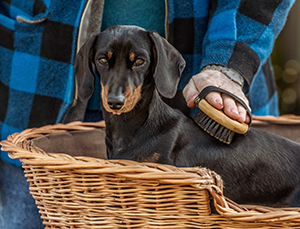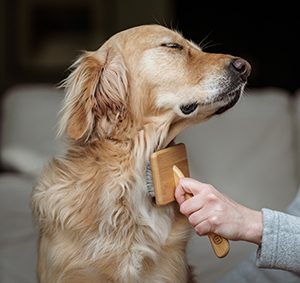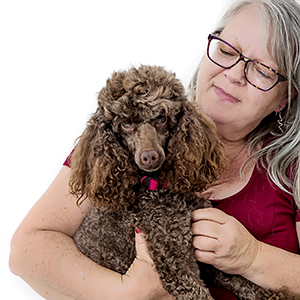How to Gain Your Dog’s Trust When Brushing Them
with Sue Williamson
For many dogs and their guardians brushing can be a very difficult activity. There are numerous reasons why this is so. For some dogs, brushing is aversive, and they will try anything to prevent brushing taking place, including biting the brush, running away, growling, etc. This makes maintaining a mat free coat extremely difficult, which often results in a matted coat needing to be completely shaved off at the groomers to prevent further matting and discomfort.
As a professional groomer, ensuring that force free brushing in between grooms is something I am passionate about. Brushing shouldn’t be a chore, it should be something to help bond, where the guardian is able to keep the coat mat free, check for any injuries, twigs, ticks, fleas extra. To ensure that this can be achieved, I came up with a technique called ‘Trust Brushing’.

Trust brushing removes the stress of brushing for both your canine companion and you and is now a technique I teach all my clients when they first bring their dog to my salon. It breaks brushing down into manageable chunks without the expectation of being able to brush the whole dog in one go – far too much for some dogs, especially when they already have a fear of being brushed.
To start this technique, make sure you are both comfortable. Ensure you choose a time of day when you are both relaxed, avoid times when you dog is active. Watching T.V. is a good time, as that also relieves the stress for you of having to achieve a full brush. Start with your dog next to you, and pick up your brush, watch his reaction, if he moves away from you, put the brush down and wait for him to return. When he returns, try picking up the brush again.
When you get to the point that he doesn’t run off when you pick up the brush, then just gently stroke the brush in a place that you know he is comfortable having touched. Just one stroke, then watch what he does – does he move away, does he give you some body language that shows he is concerned, such as a lip lick, paw lift, looking away, or moving away, or a yawn, if he does again put the brush down, then try again later. If he stays next to you, try another couple of brushes, keep it light and a short session.

As soon as he shows any concern at all, stop brushing. You may have only managed one stroke of the brush, or completed several, but by building up his confidence that you will stop as soon as it gets too much for him, he will learn to trust you and therefore be able to tolerate more brushing before he must move away.
Over time, significant progress will be made because of mutual understanding and communication.
You can do short sessions throughout the day, brushing a different area each time, so that over a couple of days you have brushed all over. This is worth the time and patience.
You may find it also helps by brushing an area he is comfortable with, then go to an area which he finds more difficult and do just one brush before returning to the comfortable area.
If he has a coat that can be clipped, I also recommend that you have him clipped short before you start this training. Getting him more comfortable with being brushed if he already has some tangles, can make progress slower, so it is best to start with a short coat, then you don’t have to stress that he may get matted whilst you do this work.
Slow and steady will win through.
If you need any further support with brushing your dog, you can join Sue’s Facebook Group “Taking the Grrr out of Grooming Dogs” or purchase her book of the same name.

